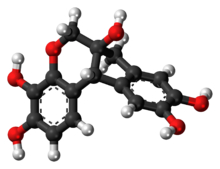
| |

| |

| |
| Names | |
|---|---|
| Preferred IUPAC name
(6aS,11bR)-7,11b-Dihydroindolo[2,1-c] [1]benzopyran-3,4,6a,9,10(6H)-pentol | |
| Other names
Hematoxylin; Natural Black 1; Hematoxyline; Hydroxybrazilin; Hydroxybrasilin; C.I. 75290
| |
| Identifiers | |
3D model (JSmol)
|
|
| ChEMBL | |
| ChemSpider | |
| ECHA InfoCard | 100.007.490 |
| MeSH | Hematoxylin |
PubChem CID
|
|
| UNII | |
CompTox Dashboard (EPA)
|
|
| |
| |
| Properties | |
| C16H14O6 | |
| Molar mass | 302.282 g·mol−1 |
| Melting point | 100-120 °C |
Except where otherwise noted, data are given for materials in their standard state (at 25 °C [77 °F], 100 kPa).
| |
Haematoxylin or hematoxylin (/ˌhiːməˈtɒksɪlɪn/), also called natural black 1 or C.I. 75290, is a compound extracted from heartwood of the logwood tree (Haematoxylum campechianum)[1][2] with a chemical formula of C
16H
14O
6. This naturally derived dye has been used as a histologic stain, as an ink[3][4][5][6] and as a dye in the textile and leather industry.[7][8] As a dye, haematoxylin has been called palo de Campeche,[8] logwood extract,[7] bluewood[9] and blackwood.[9] In histology, haematoxylin staining is commonly followed by counterstaining with eosin.[1][10][11] When paired, this staining procedure is known as H&E staining and is one of the most commonly used combinations in histology.[1][7][12][13][14] In addition to its use in the H&E stain, haematoxylin is also a component of the Papanicolaou stain (or Pap stain) which is widely used in the study of cytology specimens.[1][14]
Although the stain is commonly called haematoxylin, the active colourant is the oxidized form haematein, which forms strongly coloured complexes with certain metal ions (commonly Fe(III) and Al(III) salts).[1][7][8][15][16] In its pure form, haematoxylin is a colourless and crystalline solid,[7][17] although commercial samples are typically light to dark brown based on the level of impurities present.[2][18]
- ^ a b c d e Cite error: The named reference
Bancroft and Stevens, 1982was invoked but never defined (see the help page). - ^ a b Cite error: The named reference
Lillie, 1977was invoked but never defined (see the help page). - ^ Cite error: The named reference
Mitchell, 1908was invoked but never defined (see the help page). - ^ Cite error: The named reference
Barrow, 1948was invoked but never defined (see the help page). - ^ Cite error: The named reference
Centeno 2016was invoked but never defined (see the help page). - ^ Cite error: The named reference
Neevel, 2003was invoked but never defined (see the help page). - ^ a b c d e Cite error: The named reference
Titford, 2005was invoked but never defined (see the help page). - ^ a b c Cite error: The named reference
Ortiz-Hidalgo and Pina-Oviedo, 2019was invoked but never defined (see the help page). - ^ a b Cite error: The named reference
Ponting, 1973was invoked but never defined (see the help page). - ^ Cite error: The named reference
Chan, 2014was invoked but never defined (see the help page). - ^ Cite error: The named reference
Llewellyn, 2009was invoked but never defined (see the help page). - ^ Cite error: The named reference
Smith, 2006was invoked but never defined (see the help page). - ^ Cite error: The named reference
Kiernan, 2006was invoked but never defined (see the help page). - ^ a b Cite error: The named reference
Dapson and Horobin, 2009was invoked but never defined (see the help page). - ^ Cite error: The named reference
Titford, 2009was invoked but never defined (see the help page). - ^ Cite error: The named reference
Kahr et al., 1998was invoked but never defined (see the help page). - ^ Cite error: The named reference
Bettinger and Zimmermann, 1991was invoked but never defined (see the help page). - ^ Cite error: The named reference
Dapson et al., 2010was invoked but never defined (see the help page).